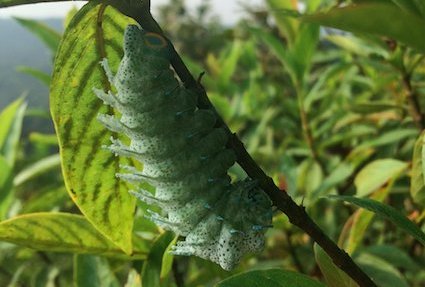
The larvae of the African maize stem borer, Busseola fusca, cause extensive damage to maize and other cereal crops across sub-Saharan Africa. Agricultural scientist and entomologist, Zeyaur Khan used techniques of chemical ecology to identify the odours that drew the stem borers to these crops, and other odours that they dislike. Armed with this knowledge, he went on to devise the push-pull strategy — a completely ecological solution for pest management — with his colleagues. In this technique, the maize is inter-cropped with Desmodium, a plant whose odour repels the pests, and the plot is surrounded by Napier grass, which smells similar to maize, attracts the pests and traps them. Adopted by more than 96,000 farmers in Africa, the push-pull strategy is among the many success stories of chemical ecology and an illustrative example of the potential of this field.
Chemical ecology is now well-established in Europe and the US, and rapidly gaining ground in China and Japan. Although there are a lot of scientists tackling chemical ecology topics in India, it is not yet recognised as an official field here. “It is somewhat unique because it is a combination of chemistry and ecological work. The way you study it can be anything from looking at molecules, cell biology, neuroscience, or evolutionary biology. The only limitation is that it is looking at how chemicals are used by organisms in the environment,” said Shannon Olsson, Assistant Professor, National Centre for Biological Sciences (NCBS), and one of the organisers of the upcoming ‘First Collaborations in Indian Chemical Ecology’ conference.
The conference, which will be held at NCBS, Bangalore from 10 – 13 September 2016, aims to create collaborations that will push the field forward in India, while showcasing the best and most advanced ideas of the field in general. It is also intended as a platform for promoting the diversity of natural systems in India and kickstarting a mutual exchange of ideas about the way forward in studying and exploring these systems. The experts of the field have a lot of knowledge about chemical ecology, but know little about Indian systems, while scientists from the Northeast are well-versed with the plant or animal systems that they are working on. Olsson emphasised that the exchange of knowledge also involves the people — not just scientists — of the Northeast, who have a lot of knowledge of ecology, in addition to a rich culture. “They have a really good connection with nature and a tremendous knowledge base. It is a mutual exchange — we learn from them while the scientists help them understand the science behind their observations,” she said.
The organisers hope that this workshop-style meeting will encourage a lot of discussion, a lot of back and forth. The preliminary program will include a lot of round table discussions. “The conference would provide a forum for generating new ideas that might open a new vista in chemical ecology research,” said Saroj Barik, an ecologist at the North Eastern Hill University, Shillong, who studies plant defense mechanisms through tri-trophic interaction in plant-herbivore-insect system and also tries to understand the chemical ecology of the only Indian pitcher plant species, Nepenthes khasiana. He is looking forward to interacting with experts to learn about cutting edge research in the field.
“Currently we have confirmed representatives from 6 continents,” said Olsson. The intent is to examine and discuss both the differences and commonalities in chemical ecology research across the world. “We think that these also are very important exchanges and we hope that it will establish more of a long-term collaboration and interest in Indian systems, and really to help preserve and promote biodiversity here,” added Olsson.
The workshop comes on the heels of a five-year project announced by the Department of Biotechnology last year, a major boost to collaborative efforts in chemical ecology between scientists in Bangalore and the Northeast. The conference will be a reflection of this program and its efforts to train people and build capacity by bringing people from different places and different academic backgrounds together and helping them find connections.
Among other outcomes, the organisers want to have a “vision document” created at the meeting, basically a list of possible ways to move forward in India in chemical ecology. One of the things the international scientists offer is a lot of history of chemical ecology. They know where the field has been, and they will have an idea of where it’s going. “We can tell them what is unique about India, and they can tell us what India can offer to the field and what the field offers to India. They can give specific examples of areas that are understudied, and that perhaps, India has a particular niche for,” said Olsson.
The deadline to apply for this meeting is 30 April 2016.